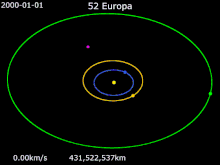52 Europa
Europa (minor planet designation: 52 Europa) is probably the 6th-largest asteroid in the asteroid belt, having an average diameter of around 315 km, though it is not correspondingly massive. It is not round but is shaped like an ellipsoid of approximately 380×330×250 km.[2] It was discovered on 4 February 1858, by Hermann Goldschmidt from his balcony in Paris. It is named after Europa, one of Zeus's conquests in Greek mythology, a name it shares with Jupiter's moon Europa.
 3D model of Europa based on lightcurve modeling | |
| Discovery | |
|---|---|
| Discovered by | H. Goldschmidt |
| Discovery date | 4 February 1858 |
| Designations | |
| (52) Europa | |
| Pronunciation | /jʊˈroʊpə/[1] |
Named after | Europa |
| 1948 LA | |
| Main belt | |
| Adjectives | Europan, Europian |
| Orbital characteristics | |
| Epoch 26 November 2005 (JD 2453700.5) | |
| Aphelion | 3.417 AU (511.201 Gm) |
| Perihelion | 2.785 AU (416.621 Gm) |
| 3.101 AU (463.911 Gm) | |
| Eccentricity | 0.102 |
| 5.46 yr (1994.629 d) | |
| 70.730° | |
| Inclination | 7.466° |
| 128.992° | |
| 343.553° | |
| Physical characteristics | |
| Dimensions | (379±16)×(330±8)×(249±10) km (mean: 315±7 km)[2] |
| Mass | (2.26±0.16)×1019 kg[lower-alpha 1][3] |
Mean density | 1.5 ± 0.4 g/cm³[2] |
| 0.2347 d[4] | |
| 0.058[5] | |
| Temperature | ~173 K max: 258K (−15 °C)[6] |
| C-type asteroid | |
| 6.31 | |
Physical characteristics
Europa is approximately the sixth largest asteroid by volume. Most likely it has a density of around 1.5 g/cm³, typical of C-type asteroids.[2] In 2007, James Baer and Steven R. Chesley estimated Europa to have a mass of (1.9±0.4)×1019 kg.[7] A more recent estimate by Baer suggests it has a mass of 3.27×1019 kg.[8]
Europa is a very dark carbonaceous C-type, and is the second largest of this group. Spectroscopic studies have found evidence of olivines and pyroxenes on the surface,[9] and there is some indication that there may be compositional differences between different regions[10] It orbits close to the Hygiea asteroid family, but is not a member.
Lightcurve data for Europa have been particularly tricky to interpret, so much so that for a long time its period of rotation was in dispute (ranging from 5 and a half hours to 11 hours), despite numerous observations.[11] It has now been determined that Europa is a prograde rotator, but the exact direction in which its pole points remains ambiguous. The most detailed analysis indicates that it points either towards about ecliptic coordinates (β, λ) = (70°, 55°) or (40°, 255°) with a 10° uncertainty.[12] This gives an axial tilt of about 14° or 54°, respectively.
In 1988 a search for satellites or dust orbiting this asteroid was performed using the UH88 telescope at the Mauna Kea Observatories, but the effort came up empty.[13]
Observations
It has been found that the reputed cataclysmic variable star CV Aquarii, discovered in 1934, was actually a misidentification of 52 Europa.[14]

Sun Earth · Mars · Jupiter · 52 Europa
Notes
- (11.39 ± 0.79) × 10−12 M☉
References
- Noah Webster (1884) A Practical Dictionary of the English Language
- Merline, W.J. (2013). "The Resolved Asteroid Program – Size, shape, and pole of (52) Europa". Icarus. 225 (1): 794–805. arXiv:1301.5101. Bibcode:2013Icar..225..794M. doi:10.1016/j.icarus.2013.01.010.
- James Baer, Steven Chesley & Robert Matson (2011) "Astrometric masses of 26 asteroids and observations on asteroid porosity." The Astronomical Journal, Volume 141, Number 5
- "Asteroid Lightcurve Parameters". Archived from the original on 14 June 2006. Retrieved 3 November 2008.
- Tedesco, Edward F.; Noah, Paul V.; Noah, Meg; Price, Stephan D. (2002). "The Supplemental IRAS Minor Planet Survey". The Astronomical Journal. The American Astronomical Society. 123 (2): 1056–85. Bibcode:2002AJ....123.1056T. doi:10.1086/338320. ISSN 1538-3881.
- "Archived copy" (PDF). Archived from the original (PDF) on 14 May 2005. Retrieved 29 April 2006.CS1 maint: archived copy as title (link)
- Baer, James; Steven R. Chesley (2007). "Astrometric masses of 21 asteroids, and an integrated asteroid ephemeris". Celestial Mechanics and Dynamical Astronomy. Springer Science+Business Media B.V. 2007. 100 (2008): 27–42. Bibcode:2008CeMDA.100...27B. doi:10.1007/s10569-007-9103-8.
- Baer, James (2008). "Recent Asteroid Mass Determinations". Personal Website. Archived from the original on 2 July 2013. Retrieved 29 November 2008.
- Dotto, E. (2000). "ISO results on bright Main Belt asteroids: PHT–S observations" (PDF). Astronomy & Astrophysics. 358: 1133. Bibcode:2000A&A...358.1133D. Archived from the original (PDF) on 14 May 2005. Retrieved 29 April 2006.
- Sawyer, Scott Raleigh (1 January 1991). "A High-Resolution CCD Spectroscopic Survey of Low-Albedo Main Belt Asteroids". PhD Thesis. Bibcode:1991PhDT.......105S – via NASA ADS.
- Zappalà, V.; di Martino, M.; Cacciatori, S (1983). "On the ambiguity of rotational periods of asteroids: The peculiar case of 52 Europa". Icarus. 56 (2): 319–324. Bibcode:1983Icar...56..319Z. doi:10.1016/0019-1035(83)90041-6.
- Michałowski, T (2004). "Photometry and models of selected main belt asteroids I. 52 Europa, 115 Thyra, and 382 Dodona" (PDF). Astronomy & Astrophysics. 416: 353–366. Bibcode:2004A&A...416..353M. doi:10.1051/0004-6361:20031706.
- Gradie, J.; Flynn, L. (March 1988), "A Search for Satellites and Dust Belts Around Asteroids: Negative Results", Abstracts of the Lunar and Planetary Science Conference, 19, pp. 405–406, Bibcode:1988LPI....19..405G.
- "CV Aquarii identified with (52) Europa" (PDF). Archived from the original (PDF) on 14 February 2006. Retrieved 29 April 2006.
Bibliography
- PDS lightcurve data
- Sawyer, S. R. (1991). A High-Resolution CCD Spectroscopic Survey of Low-Albedo Main Belt Asteroids PhD thesis (Thesis). The University of Texas. Bibcode:1991PhDT.......105S.
- Schmeer, P., and M. L. Hazen, CV Aquarii identified with (52) Europa, Journal of the American Association of Variable Star Observers, Vol. 28, p. 103 (2000).
External links
- "Elements and Ephemeris for (52) Europa". Archived from the original on 4 March 2016. Retrieved 26 May 2011.
- shape model deduced from lightcurve
- 52 Europa at AstDyS-2, Asteroids—Dynamic Site
- 52 Europa at the JPL Small-Body Database
